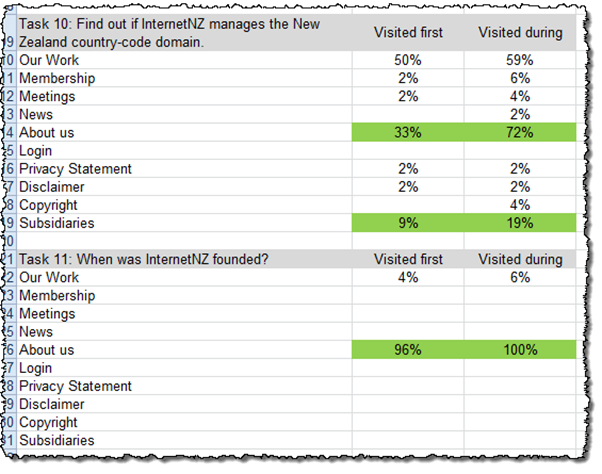When we’re evaluating a site structure, one of the key things to get right is our top-level navigation, also known as “level 1”. These are typically the headings that appear in the global navigation, often as tabs across the top of the site:

Note that top-level navigation also includes the utility links that appear in the header and footer of most sites (items such as Login, My Account, FAQ, and so on). They’re less prominent than the main headings, but that’s a visual-design choice, and in tree testing we purposely don’t factor in things like visual design.
It’s crucial to get our top-level headings right:
An obvious way to test the effectiveness of our top-level headings is to look at the clicks they made from the “home” node of our tree. This includes two cases:
While we can dive in and examine click paths to see where the top-level clicks are going, most tools provide an easier way to see this.
In Treejack, for example, the “First Click” tab that shows, for each task, which top-level headings were clicked. Here’s an example from the InternetNZ tree test that we saw earlier in this chapter:

Task 11 (above) shows a task where the top-level headings were very effective. 96% of participants went to the right section (About us, highlighted in green) on their first click (the “Visited first” column). Besides that high score, notice also that they agreed on where to go – only 1 other top-level heading got any traffic at all.
Task 10, on the other hand, shows how the same top-level headings were not effective for a different task. Only 42% of participants got their first-click right (split between the two correct paths), while 50% mistakenly went to Our work. Notice also that several other top-level headings got traffic; this kind of “noise” shows that there was much less agreement on where the correct answer should live.
The “Visited during” column shows us how often the top-level headings were clicked as a second (or third) try after the participants backtracked from their first choice. For Task 10 above, the About us section only got 33% of first clicks, but that number increased to 72% when we added all subsequent clicks. This tells us that many participants made it their second choice after Our work. This in turn suggests that if we could keep people from going to Our work for this task, About us would likely become their first choice, raising our test score.
When we look at top-level clicks for a task, then, we’re mainly looking for two things:
Top-level clicks can help us fix specific problems with individual tasks. But as we saw above, top-level headings may work well for one task and not for another. We need to look at all the tasks in our study to come up with a total assessment of our top-level headings.
Next: Directness – where they backtracked